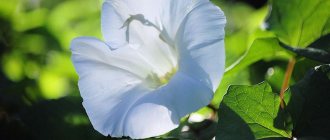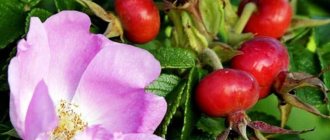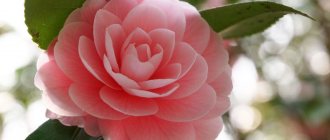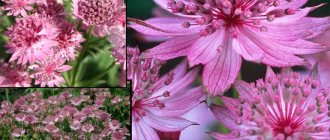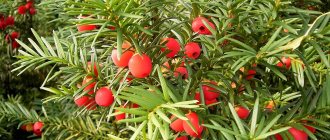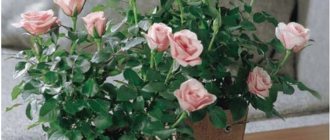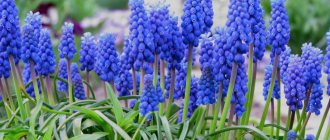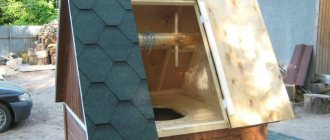Toffee should be planted at a distance of 25 cm from other crops. If it is used to fill the territory, then the distance from other plants is 50-60 cm.
Description and features of bindweed
It is a perennial or annual herbaceous plant or shrub. It reaches a height of 4 m, has creeping or erect stems, a creeping root system with thread-like roots.
Whole, alternate leaves are located on petioles. They are arrow-shaped or heart-shaped, with teeth or divided into lobes.
The flowers are arranged singly or in inflorescences in the axils of the greenery. Their shape is funnel-shaped or bell-shaped, while the blades are weakly defined. Opens its petals in the early morning, only in clear weather.
After flowering, fruits begin to form. These are boxes containing seeds. They retain germination for 2-3 years after collection.
General characteristics
In nature, birch trees can be found in your garden. It resembles a miniature vine. By the way, the Latin name for loach means “to roll up” or “to wrap,” which very accurately conveys the character of the plant. The stems and rhizomes resemble thin cables that expertly wrap around any structure: living or not. The question of what bindweed looks like should be answered with a description of each of its parts separately:
- Flower. The long peduncle is located in the axil of the leaf. Sometimes he throws out whole inflorescences. The flowers are very delicate and therefore easily damaged. They have the shape of a small bell or a large funnel. They close at night and open in the morning.
- Leaves. In simple species, the leaves look like a heart or an arrowhead. But decorative varieties come in a round shape or with jagged edges. They are located on the stem in a checkerboard pattern, in a spiral.
- Rhizomes. Thread-like creeping roots professionally loosen the soil and penetrate quite deeply. With each break, another shoot is formed, which is why birch is considered a nuisance weed.
- Stems. They reach 3-4 meters in length. In some species the stems are erect (up to 50 cm in height), while in others they are creeping. They entwine objects so tightly that they can hardly be torn off.
- Fetus. It is a miniature box filled with medium-sized seeds (from 100 pieces in one gram). The seed retains its fertile properties for three years.
The value of this culture is also that it has many colors. As shown in the photo, bindweed can be one-color, two- or three-color. The dominant shades of these “European vines” are:
- white;
- pink (pale or deep);
- violet;
- blue or light blue;
- red (sprayed).
Loaches begin to bloom in late spring. As a result, the whole summer and until the autumn frosts you can admire the splendor of these delicate flowers.
Representatives of the Bindweed family need to be grown in non-acidic and relatively moist soil. You should also provide them with sufficient lighting, or at least diffuse lighting.
Types and varieties of bindweed
The genus includes 75 varieties, the identity of another 836 has not yet been precisely established. Only some species are common in Russia.
Field
Perennial or annual, reaching a length of 1-1.5 m. The flowers are small, growing along the entire smooth or fleecy stem. They come in a variety of colors: most often snow-white or pinkish, less often blue, light blue or violet. Flowering period: from the second decade of spring until frost. Reproduction occurs by seeds or root suckers.
Typically, field bindweed (ordinary) is destroyed in vegetable gardens and summer cottages, because it grows very quickly and entangles other crops, taking away their vitality. However, it also has benefits that not everyone knows about. Plants planted nearby are less likely to be affected by mold or mildew. Field bindweed also makes good mulch.
The plant also has healing properties. It perfectly helps with pathologies of the kidneys and liver, treats respiratory diseases, and cleanses the circulatory system.
Garden
A distinctive feature is the variety of contrasting and bright colors. A flowering carpet can decorate an unsightly slope on a site, an empty space or an alley. Garden bindweed is also used to decorate borders and create partitions. They can separate one part of the site from another and shade the remaining crops. Popular varieties:
| Name | Description | Flowers |
| Mauritanian | Up to 0.5 m. Usually grown in containers or hanging pots. The foliage is grayish-malachite in color. | Light lilac. |
| Double-vertex | Up to 0.4 m. In the wild, it can be found on mountain slopes, sandy shores of reservoirs, and in the steppes. Stems creeping or slightly erect. The plates are arrow-shaped, bare or pubescent. | Single, pudding. |
Tricolor
Exotic decorative vine up to 0.5 m in length. The foliage is bluish-emerald, densely planted along the entire stem. Large flowers with wavy edges reach 5 cm in circumference.
The most beautiful varieties:
- Blue and Rainbow Flash with whitish ultramarine flowers, lemon pith;
- Royal Ensign with velvety purple petals with a black tint;
- Crimson Monarch with bright raspberry buds.
Tricolor bindweed is a low-growing plant with a large number of side shoots, giving the bush the shape of a sphere. This variety looks impressive in containers on terraces, loggias, window sills, and balconies.
Climbing perennials for the garden with photos and names
Climbing perennial flowers are more suitable for those summer residents who rarely visit their country house. Perennial vines are easy to care for and are almost the first to show their greenery in the spring, weaving around a fence or climbing a wall. There are many types of loaches, among which you can choose for practical and aesthetic reasons.
Actinidia
Actinidia was cultivated not so long ago, but it already has 75 species of loaches, many of which can be easily grown in mid-Russian latitudes. In nature, actinidia grows in Southeast Asia, the Himalayas, and the Far East.
The perennial loach demonstrates its decorative properties throughout the growing season, changing the color of the leaves from soft green with a bronze tint to dark with a white tint and, finally, becoming a pink or raspberry bush.
Ampelopsis
Ampelopsis belongs to the Grape family, but it is famous for its unusual and very attractive appearance. Perennial loach in climates with cold winters reaches 3 m in height. Its leaves resemble grape leaves, but each type has its own color. The stems are reddish-purple in color. The loach clings to the support with its long antennae. Small ampelopsis fruits are unsuitable for food. However, they very brightly decorate the perennial loach with their various shades: yellow, red, blue, purple.
Azarina
Azarina climbing is a perennial loach, from the root system of which several new shoots grow annually. But this happens only in a warm climate zone at a constant temperature of at least +200C. On the territory of Russia, loach can be grown either as an annual or as a perennial, but in indoor conditions.
This loach has highly branching shoots and is capable of growing quickly in any direction. With its help you can landscape a loggia, terrace, gazebo, or create a decorative emerald wall of dark green velvet leaves with large bell flowers of different colors.
Wisteria
In nature, wisteria grows freely in the humid subtropical forests of Japan, China, and Korea. This loach with drooping branches-lianas can reach a height of 15-18 m. The perennial is widely used in many countries in landscape design, decorating gardens and parks with an unusually bewitching appearance of purple, white, blue, pink flowers collected in large inflorescences-tassels. It’s not for nothing that the Japanese call a walk surrounded by wisteria flowers a “walk through the Garden of Eden.”
Attention! The flowering of Chinese wisteria can be enjoyed only 3 years after planting the loach, and Japanese - only in the 10th year of the perennial’s life.
Hydrangea
Hydrangea can be seen as a small tree, shrub or loach climbing a support 30 m. Hydrangea flowers are small, they are collected in huge spherical inflorescences and come in different colors: white, pink, purple, blue. In Japan, this loach is called "ajisai", which translates as "purple sun flower". A very winter-hardy perennial loach that can withstand harsh winters.
Hop
An enterprising gardener with skill can use the fast-growing ability of perennial vines like hops (shoots can grow up to 20 cm per day) to create vertical green walls with large, bright green foliage and attractive buds.
In mid-latitudes, common hops are grown - a climbing perennial, the upper part of which completely dies off by winter. This allows the gardener to clear the area and prepare supports for next year.
Clematis
Clematis has about 300 species and grows on all continents under different climatic and natural conditions. Most of them are climbing vines with long flexible shoots. In northern and middle latitudes, clematis shoots die off during the winter, and the next year they grow from dormant buds on the underground part of the vine.
Clematis flowers can be small or large, single or collected in inflorescences. Colors can vary from white to dark blue and purple. The flowering of the perennial loach begins in spring and lasts until the first frost.
Princes
Knyazhik is a perennial shrubby loach with a woody stem. It climbs up to 2 m in height, clinging to supports with twisted leaf petioles. Very similar to clematis. Both loaches belong to the same genus, but differ in flowers. Prince has 8 types, differing in colors. Half of them are frost-resistant. This quality makes it possible to successfully grow perennial loaches throughout Russia.
Comment! All types of princeling bloom at different times. The right combination of them will help the gardener create a beautiful long-blooming composition.
Fallopia
Fallopia can be either annual or perennial. The loach has a stem up to 5 m long. Its ability to quickly fill empty spaces can be successfully used to cover up unsightly spaces. Refers to climbing perennials that bloom all summer. The flowers are small, collected in inflorescences. Some types of loaches are good honey plants.
climbing rose
Climbing roses are considered leaders in vertical gardening. Their lush flowering, rising along the installed support, captivates all flower lovers. Loaches are divided into 2 main groups:
- Ramblers - have arched or creeping shoots up to 5 m long.
- Climbers - a climbing vine obtained by crossing several varieties.
A climbing rose can decorate any structure: both large and small, entwining a gazebo, arch, column, fence. The beautiful combination of climbing perennials with other plants allows you to create extraordinary compositions.
Kampsis
The beautiful, fast-growing Campsis loach is native to North America and China. In Europe, they have been decorating gardens and parks since the 17th century. The spreading stems are covered with large, bright, tubular flowers up to 8 cm in diameter. The petals, fused at the base into a corolla, are colored orange, pink, or crimson. The perennial grows successfully in central and southern Russia.
Honeysuckle
Honeysuckle is a climbing perennial, a deciduous shrub that grows up to 6 m in height. It is grown for decorative purposes for vertical gardening. The plant is unpretentious, grows quickly up to 120-170 cm per year. Blooms profusely from spring to autumn with bright red-orange or light purple flowers with a pleasant, persistent aroma. In autumn, the loach is covered with beautiful bright red inedible fruits.
Ivy
Ivy is a perennial loach. They are widely used in vertical and hanging gardening thanks to the adventitious roots with which ivy firmly clings to everything it encounters on its way. Loach is famous for its unpretentiousness and rapid growth. Large leaves of different shapes, which can be green, variegated, yellowish, with a white border and red splashes, give the loach its decorative appearance.
Woodplier
Wood pliers is a lignified perennial loach that naturally lives on both American continents, Central Asia, Africa and Australia. The tree pliers got their name from their parasitic lifestyle. Thanks to its rapid growth, the loach wraps around a nearby growing tree and grows inside the trunk, drinking the juices of the donor. Due to its abundant green mass and orange fruits, wood pliers have found their use in landscape design for landscaping fences, gazebos, and building walls.
Attention! Wood pliers should not be planted near trees to avoid their death.
Clematis
Clematis belong to the buttercup family and are climbing and creeping perennials. They grow in temperate climates along river banks, on cliffs and rocks, in the steppe zone. They have leaves of different shapes and flowers, small or large, of different colors. They are very whimsical and require a lot of light, heat, water and fertile soil. Loaches have found wide application for covering walls, trellises, decorating balconies, and borders.
Kirkazon
Kirkazon has many other names:
- aristolochia;
- fever grass;
- woman in labor;
- kokornik
This perennial loach belongs to the very ancient genus Karkizon, which existed even before the division of the land. It has a creeping rhizome, weakly branched shoots that grow up to 8-14 m in length. It also has decorative large leaves that create a dense and spectacular foliage cover.
Growing bindweed from seeds
The flower is propagated only by seeds. They can be sown directly into an open area or planted as seedlings. Pre-growing from seeds indoors is preferable, so the bush will grow faster and bloom more profusely.
Sowing of seedlings is carried out in March:
- Leave the seeds in water for a day.
- Place in separate containers with soil mixture for flowering plants. It is not advisable to plant in common containers, because bindweed does not tolerate transplantation well.
- Deepen the seed and cover it with a thin layer of soil.
- Keep pots at +18…+20° C.
- Apply mineral fertilizers. Water regularly, not allowing the soil to dry out.
- The first shoots will sprout after a couple of weeks.
Climbing perennials in landscape design
Perennial vines are widely used by gardeners for landscaping. Their diversity, which currently exists, helps solve many issues regarding the improvement of a garden plot:
- give the feeling of a cozy oasis;
- cover unsightly buildings, camouflage old trees;
- divide the garden into zones (for example, rest and work);
- create a picturesque alley;
- make a living screen to protect from dust, sun, noise, and prying eyes;
- decorate arches, gazebos, balconies and other elements of the garden with abundant flowering vines.
Perennial loaches have their advantages over annuals. They are cold-resistant, do not require annual planting, survive winter well in open ground and do not require special care.
Planting bindweed in the garden
Before planting, seedlings must be hardened off. To do this, she is taken outside every day, starting from 10 minutes, gradually increasing the time of “walks”. Thanks to this, the bindweed will have a stronger immune system and will be able to resist various diseases.
Landing dates
Planting is done after the snow melts, when the risk of frost returns disappears. This usually happens in mid-May to the first half of June.
Landing technology
It is necessary to choose a sunny place. Only in this case will it bloom magnificently and for a long time. The flower is unpretentious to soil mixtures, but grows better on a permeable, loamy substrate. Landing occurs as follows:
- Dig up an area with peat (2-3 kg per 1 sq.m).
- Level the ground surface.
- Move the plants into holes located at a distance of 20-25 cm from each other using the transfer method. Before transplanting, water the seedlings (it will be easier to remove the bushes from the pots).
- Moisten thoroughly.
Caring for bindweed
Planting and further care of the plant are simple. It is enough to fulfill some requirements:
| Criterion | Recommendations |
| Watering | Regular and plentiful. If there is a lack of moisture, the flower will drop its petals. When moisturizing, make sure that there is no stagnation of liquid. Because of this, a fungal infection may begin to develop. |
| Top dressing | If growth is slow, add wood ash or fertilizer for flowering plants. For example, Nitrophoska, Agricola. |
| Weeding | In the first 2-3 weeks after planting. When the bushes get stronger, they will be able to suppress weeds. |
| Formation | It is necessary to create a support so that the bindweed can entwine it during active growth:
When a flower grows in the wrong direction, prune it. |
After flowering
In Russia it is grown as an annual plant. Therefore, in mid-autumn it is necessary to dig it up with its rhizome and dig up the area. Since the flower has the ability to self-sow, new specimens will begin to form in the same place next season.
Tips for growing climbing perennials
Conditions for growing climbing and creeping perennials vary and depend on where the plant comes from. Therefore, you need to approach the selection of a perennial and the creation of growing conditions with an understanding of what the loach needs.
However, some growing conditions are the same for all loaches:
- the correct selection of location (sun or shade) will ensure rapid growth of the perennial;
- Loaches should not be planted close to a fence or wall; the distance should be at least half a meter so that the root system is freely located in the soil;
- supports must be placed before planting the perennial, calculating the weight that will fall on the support from the loach;
- In order for a perennial to have a decorative appearance, you need to direct its growth from the first day, create volume and trim off fading branches.
The right combination of different varieties of climbing perennials, blooming at different times, will create a unique look for your garden plot.
Diseases and pests
Bindweed is a robust plant that is rarely affected by disease or insects. Sometimes, in the absence of proper care, a flower gets powdery mildew. It can be identified by the following signs:
- White powdery spots containing fungal spores. After a while, they begin to secrete liquid drops that resemble dew.
- Early petal fall.
- Curling and wilting of foliage.
- Stopped development.
The disease most often occurs due to errors in care:
- high humidity;
- aphid damage;
- excess nitrogen in the soil;
- excessive planting density.
Fungal spores can also enter with water during watering or from other plants through the wind, through a person or undisinfected equipment.
If the damage is severe, the flower dies; in the initial stages of the disease, it can still be saved:
- Remove affected areas.
- Spray with soda ash (2-3 g per 1 liter of water) or soap-copper solution (25 g of green soap and 2.5 g of copper sulfate per 1 liter of liquid).
- Treat the bush itself, containers, and soil with Vitaros, Fundazol, Topaz, Hom or other fungicides.
Occasionally, aphids begin to live on bindweed. Insect pests can be recognized by the following signs:
- wilting of young leaves and buds;
- dark spots (punctures from proboscis);
- syrupy liquid on the aerial part;
- the appearance of ants near the plant (they are attracted by sticky mucus).
You can destroy the insect in the following ways:
- wipe the above-ground part with a cloth soaked in soapy water;
- purchase larvae of red ants or ladybugs at a gardening store (these are natural enemies of the pest);
- use purchased drugs: Commander, Bankol, Vertimek and others.
Mr. Summer Resident informs: how to get rid of field bindweed
Wild bindweed can be a problem in your garden. By entwining other plants, it suffocates them and prevents them from growing normally.
A fast-growing weed should be destroyed while it is still young. It must be completely torn out without leaving roots in the ground. New shoots can begin to form from them. Collect all parts of the plant carefully so that the seeds do not scatter and burn. If this does not help, then it is advisable to use poisonous drugs: Linder and others.
To avoid unwanted growth of bindweed in the future, dig up all the soil in the spring, destroying the remaining roots. After this, cover the area with material that does not allow light and air to pass through. Under such conditions, the remaining parts of the plant will die. Green manure also helps prevent unwanted weed growth. For example, white mustard.
Briefly about the main thing
Loaches are ideal for vertical gardening; with the help of planting such plants, you can zone a site, decorate the facades of houses, mask their defects, and completely cover fences and outbuildings with a green blanket.
There are a large number of decorative species, including creeping and creeping vines. In order for everyone to reveal their beauty, it is necessary to choose the right support for it.
The rules for creating vertical gardening are extremely simple; it is important to take into account the frost resistance of loaches, its compliance with existing climatic conditions, and the growth pattern of the vine.
Gardeners necessarily include azarina, aconite, clematis, wisteria, virgin grapes and perennial morning glory in the list of the most popular loaches.
Ratings 0
